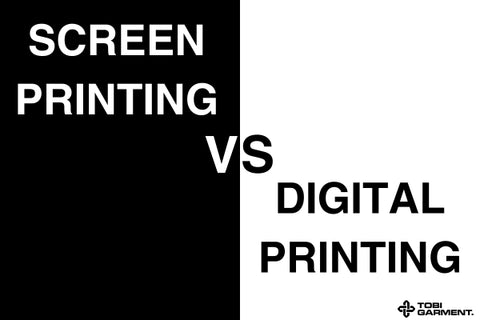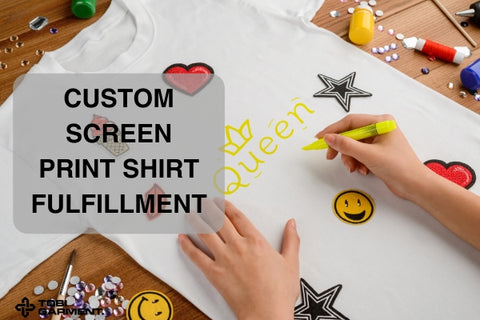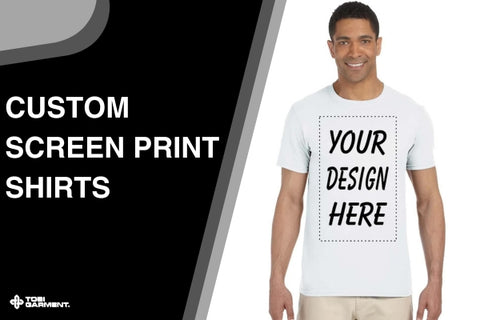
Choosing between screen printing and digital printing can be overwhelming, especially for those new to the world of custom printing. Both methods offer unique advantages and disadvantages, making it essential to understand their key differences before making a decision. In this comprehensive guide, we'll delve into the intricacies of screen printing and digital printing, helping you determine which method is best suited for your specific needs.
Understanding Your T-Shirt Printing Needs
Before embarking on your t-shirt printing journey, it's essential to assess your specific requirements. Consider the following factors to help you make an informed decision:
Project Requirements
- Quantity: Are you looking to print a large number of t-shirts or just a few?Design Complexity: Is your design intricate and detailed or simple and minimalistic?
- Printing Surface: Will your t-shirts have a light or dark background?
Target Audience
- Age: Are you targeting a younger demographic or a more mature audience?
- Style: Do you want to create a vintage, modern, or trendy look?
- Message: Is your design conveying a specific message or emotion?
Desired Look and Feel
- Softness: Do you prefer a softer hand feel or a more textured finish?
- Durability: How important is the longevity of your printed t-shirts?
- Washability: Will your t-shirts be subjected to frequent washing?
By clearly defining your project requirements, target audience, and desired look and feel, you'll be better equipped to choose the printing method that aligns with your vision and budget.
Read more: Top Hoodie Print Placements: Make Your Hoodie Stand Out
Key Differences Between Screen Printing and Digital Printing
Screen printing and digital printing may seem similar on the surface, but they differ in several key aspects:
Cost
- Screen Printing: Ideal for large quantities and cost-effective for simple designs with fewer colors. The initial setup cost can be higher, but the per-unit cost decreases as the quantity increases.
- Digital Printing: More cost-effective for smaller quantities and complex designs with intricate details and gradients. The per-unit cost remains consistent regardless of quantity.
Quality
- Screen Printing: Produces vibrant colors and sharp edges, especially on dark backgrounds. The ink is thick and durable, making it suitable for heavy-duty use and frequent washing.
- Digital Printing: Offers high-resolution prints with exceptional detail and color accuracy. The ink is thinner and may not be as durable as screen printing, but it's suitable for most everyday wear.
Speed
- Screen Printing: The setup process can be time-consuming, but once the screens are ready, the printing process is fast, allowing for high-volume production.
- Digital Printing: Offers quicker turnaround times, as it eliminates the need for screen preparation. The printing process is direct, making it ideal for small orders or last-minute requests.
Customization
- Screen Printing: Allows for a wide range of customization options, including special effects like puff, metallic, or glow-in-the-dark inks. However, each color requires a separate screen, making complex designs more costly.
- Digital Printing: Offers endless possibilities for customization, as it can handle intricate designs with gradients, photographs, and complex color combinations.The process is more flexible and adaptable to individual preferences.
Read more: Building Your Own DIY Dry Box: A Step-by-Step Guide
Choosing the Right Method for Your T-Shirts
Now that you understand the key differences between screen printing and digital printing, it's time to decide which method best suits your needs:
Screen Printing for Large Quantities
If you're looking to print a large number of t-shirts with simple designs, screen printing is the way to go. It's cost-effective, durable, and perfect for creating bold, eye-catching prints on dark backgrounds. Screen printing is also ideal for special effects and custom finishes, making your t-shirts stand out from the crowd.
Digital Printing for Customization
Digital printing is the perfect choice if you want to create unique, personalized t-shirts with intricate designs, photographs, or complex color combinations. It's ideal for small orders, last-minute requests, and those who prefer a softer hand feel. Digital printing also allows for quick turnaround times, making it a convenient option for those with tight deadlines.
Hybrid Approach
For those who can't decide between screen printing and digital printing, a hybrid approach might be the solution. By combining the strengths of both methods, you can create t-shirts that are both visually stunning and cost-effective. For example, you can use screen printing for the main design elements and digital printing for smaller details or personalization.
Read more: Eco-Friendly Screen Printing: Your Guide to Sustainable Style
Additional Considerations
When choosing between screen printing and digital printing, there are a few additional factors to keep in mind:
Sustainability
As environmental consciousness continues to grow, many t-shirt enthusiasts are looking for eco-friendly printing options. Digital printing generally uses less water and produces less waste than screen printing, making it a more sustainable choice. However, screen printing has also made strides in reducing its environmental impact through the use of water-based inks and eco-friendly practices.
Care Instructions
It's important to consider how your printed t-shirts will be cared for. Screen printing is generally more durable and can withstand frequent washing and drying, while digital printing may require more gentle care to maintain the quality of the print.
Legal and Intellectual Property
If you're using copyrighted designs or characters, it's crucial to ensure that you have the necessary permissions and licenses. Both screen printing and digital printing can be used to reproduce protected designs, so it's essential to stay informed about intellectual property laws and regulations.
Read more: A Beginner's Guide to Screen Printing on Garments
Conclusion
In the ever-evolving world of custom apparel, screen printing and digital printing continue to push the boundaries of creativity and innovation. By understanding the key differences between these two printing methods and considering your specific needs, you can elevate your t-shirt game to new heights in 2024.
Remember, the choice between screen printing and digital printing ultimately comes down to your project requirements, budget, and personal preferences. Don't be afraid to experiment and explore the possibilities that each method offers. With a little creativity and the right printing technique, you can create t-shirts that are not only visually stunning but also reflect your unique style and personality.
FAQ
1. What is the main difference between screen printing and digital printing?
Screen printing uses a stencil and ink to create designs, while digital printing uses a printer to directly print designs onto the fabric.
2. Which method is better for large quantities?
Screen printing is generally more cost-effective for large quantities, as the per-unit cost decreases as the quantity increases.
3. Can digital printing handle intricate designs?
Yes, digital printing is well-suited for intricate designs with gradients, photographs, and complex color combinations.
4. Is screen printing more durable than digital printing?
Screen printing generally produces more durable prints, as the ink is thicker and can withstand frequent washing and heavy-duty use.
Read more related posts from Tobi Garment:



